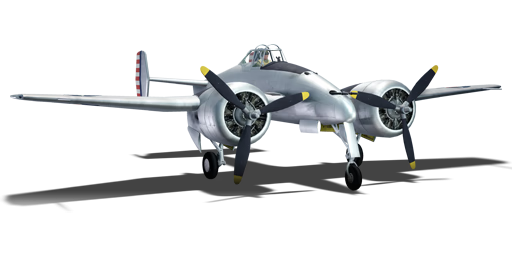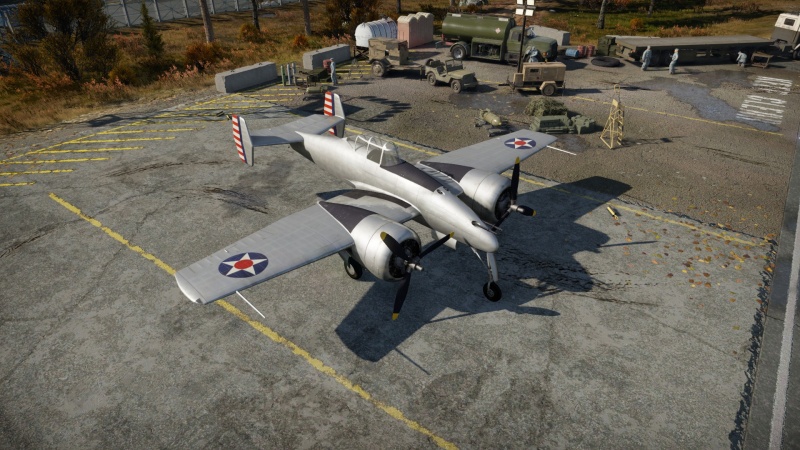XP-50
Contents
Description
In 1939, the U.S. Army issued Circular Proposal 39-775 for new fighters that could utilize new engines. Of the four companies that submitted designs, Grumman submitted Design 41 which was largely based on Design 34 (XF5F-1) but would utilize two Wright R-1820 radial engines. Although Lockheed’s design was deemed more favorable, the Army wanted Grumman to continue revising Design 41 as a backup in case Lockheed’s proposal ran into hiccups. Grumman’s resubmission, Design 45, was later given the designation XP-50. The XP-50 was fitted with two Wright R-1820-67/69 radial engines which produced 1,200 hp with the help of turbosuperchargers. The XP-50 was promising in test flights until a turbosupercharger explosion led to the loss of the prototype. The XP-50 project was then canceled.
Introduced as a premium aircraft in Update 1.31, the XP-50 is an extremely capable aircraft. With the help of an airspawn, the XP-50 can reach heights well above enemy aircraft with ease. Although it is quite manoeuvrable, at higher speeds the XP-50 struggles with compression. Players must be careful when diving for opponents, especially with how quickly the XP-50 gains speed and the lack of airbrakes. The XP-50 also has two 20 mm cannons and two 12.7 mm machine guns mounted in the nose. However, the cannons are greatly limited in their ammo pool. Nonetheless, the XP-50 is a great plane for beginners to practice energy fighting and ammo conservation.
General info
Flight performance
The XP-50 has great climb rate and acceleration, although it does tend to lock up at high speeds. It can easily maintain a 20-25 degree climb. Your engines will also commonly overheat, but they cool off relatively quickly. Low-speed manoeuvrability is excellent, especially when you have your flaps deployed.
| Characteristics | Max Speed (km/h at 6,700 m) |
Max altitude (metres) |
Turn time (seconds) |
Rate of climb (metres/second) |
Take-off run (metres) | |||
|---|---|---|---|---|---|---|---|---|
| AB | RB | AB | RB | AB | RB | |||
| Stock | 662 | 646 | 10400 | 19.8 | 20.4 | 17.2 | 17.1 | 444 |
| Upgraded | 698 | 680 | 18.2 | 19.0 | 23.0 | 20.0 | ||
Details
| Features | ||||
|---|---|---|---|---|
| Combat flaps | Take-off flaps | Landing flaps | Air brakes | Arrestor gear |
| ✓ | ✓ | ✓ | X | X |
| Limits | ||||||
|---|---|---|---|---|---|---|
| Wings (km/h) | Gear (km/h) | Flaps (km/h) | Max Static G | |||
| Combat | Take-off | Landing | + | - | ||
| 745 | 370 | 465 | 436 | 290 | ~11 | ~7 |
| Optimal velocities (km/h) | |||
|---|---|---|---|
| Ailerons | Rudder | Elevators | Radiator |
| < 350 | < 400 | < 400 | > 300 |
| Compressor (RB/SB) | ||
|---|---|---|
| Setting 1 | ||
| Optimal altitude | 100% Engine power | WEP Engine power |
| 5,520 m | 2,200 hp | 2,398 hp |
Survivability and armour
- 9.5 mm steel - bulkhead in front of the cockpit
- 9.5 mm steel - behind the pilot
- Self-sealing fuel tanks (1 below the pilot, 1 fuel tank behind pilot)
Modifications and economy
Armaments
Offensive armament
The XP-50 is armed with:
- 2 x 20 mm AN/M2 cannons, nose-mounted (60 rpg = 120 total)
- 2 x 12.7 mm M2 Browning machine guns, nose-mounted (500 rpg = 1,000 total)
Usage in battles
Its excellent climb rate and acceleration make this plane great for energy fighting. It won't be hard to get altitude advantage upon the majority of your opponents, since you get an airspawn, while also having a great climb rate.
Use your climb rate to be the highest plane of the battle, unfortunately, this aircraft does not have WEP, as so, it is best to climb at a 20-25 degree angle to get to altitude. Your priority targets are the highest enemies where you can pick and choose and work your way down to lower aircraft as needed.
If you notice you were out-climbed, don't hesitate to roll away and climb more as a dive is a risky trade with this plane. If an enemy climbs to catch you, make a 90° climb at full power and when they start to stall, try to boom & zoom them. Use your acceleration and/or climb rate if someone gets on your six to lose them. If you do lose energy, do not worry. You turn extremely well at low speeds with your flaps out and will out turn most things you fight.
If you do get in trouble, the first thing you should do is climb. You will outclimb most enemies, and after this, use this energy you gained to get the upper hand in a dogfight. You having more energy will make you more effective at turning and help you outmaneuver your enemies. After you are able to get behind them, your maneuverability helps you stay behind them to get a easy shot.
Make sure to have a disciplined and accurate fire, since you will quickly chew through the ammunition. While you may only have 120 rounds total of the cannon rounds, it doesn't take a lot of hits to knock out enemy aircraft. Your guns are extremely accurate and they are nose-mounted. Gun convergence can safely be set to 800 m, however, accuracy is best when close in, around 200-300 m. It is recommended to take Air Targets belts for the cannons and the Universal belt for the machine guns to maximize the damage output for air-to-air engagements.
When attacking bombers, try your best to stay away from the rear as that is a very dangerous spot for your aircraft to attack from. The engines can easily be damaged by gunners if the shots are aimed properly so try your best to attack from the top or bottom or even peel off if needed. This aircraft has poor fire extinguishing and flying with one engine can be dangerous.
Manual Engine Control
| MEC elements | ||||||
|---|---|---|---|---|---|---|
| Mixer | Pitch | Radiator | Supercharger | Turbocharger | ||
| Oil | Water | Type | ||||
| Controllable | Controllable Not auto controlled |
Controllable Not auto controlled |
Controllable Not auto controlled |
Separate | Controllable 1 gear |
Auto controlled |
Pros and cons
Pros:
- Excellent climb rate
- Gets an airspawn
- Great acceleration
- Good manoeuvrability
- Powerful weaponry, thanks to the two AN/M2 cannons
- Good cockpit visibility
- The engine quickly cools down if you idle the power
- Good dive speed
Cons:
- Only 120 cannon shells and, once gone, only two .50 MGs
- No WEP available in RB/SB
- Manoeuvrability not as responsive during long steep dives (control surface compression)
- Fragile airframe
- No suspended armament
History
| Archive of the in-game description | |
|---|---|
|
Grumman XP-50 twin-engine army fighter prototype Practically at the same time the XF5F-1 Skyrocket carrier-based fighter was being created, Grumman Aircraft Engineering Corporation designers worked on the development of a promising interceptor, based on the XF5F-1, for the United States Army Air Corps. The prototype was given a company designation of Model G-46 and an army designation of ХР-50. The USAAC issued an order for production of the new aircraft on November 25, 1939. Although the ХР-50 was similar to the XF5F-1 externally, a number of significant changes were introduced into the original layout. Unlike its carrier-based predecessor, the ХР-50 was not a low-wing but a mid-wing monoplane, the fuselage was significantly lengthened, the shape of the pilot's cockpit canopy was changed, and the tailplane span was reduced. The plane was powered by two Wright XR-1820-67/79 Cyclone nine-cylinder, air-cooled engines, with a left- and right-handed reduction gear, producing a takeoff power of 1,200 hp. Due to the new engines installed, the shape of the nacelles and engine cowlings was changed. The aircraft's armament included two 20 mm Hispano-Suiza AN-M2 cannons, with 60 rounds each, and two 12.7 mm Colt-Browning AN-M2 .50 cal machine guns, with 500 rounds each, mounted in the forward fuselage. In addition, the aircraft could carry two 100 lb (45 kg) bombs under its wing panels. Instead of the XF5F-1's tail wheel, the ХР-50 had a nose landing gear. The plane's fuel tanks were self-sealing, and the pilot was protected just as he was in the Navy version, i. e. with the help of an armoured front bulkhead, an armoured backrest, and an armoured floor. The XP-50 (Ser No. 40-3057) prototype got off the ground for the first time on 18 February 1941, with Robert Hall, a Grumman test pilot, at the controls. The test flights showed that the ХР-50 had a better controllability than the XF5F-1. In addition, the turbosupercharged engines ensured the ХР-50's much better characteristics at medium and high altitudes. On 14 May 1941, during the 15th test flight of the ХР-50 prototype, the turbosupercharger of one of the engines was destroyed, the cause undetermined, and the turbine blades flying in all directions severed the line running to the hydraulic nose landing gear extension system. Pilot Robert Hall successfully bailed out of the damaged vehicle. After the first prototype was lost, all work on the ХР-50 was discontinued. | |
Media
- Skins
See also
- Related development
- Similar airframe
External links
| Grumman Aircraft Engineering Corporation | |
|---|---|
| Aircraft | |
| Fighters | |
| F3F | F3F-2 · Galer's F3F-2 |
| F4F Wildcat | F4F-3 · F4F-4 |
| XF5F Skyrocket | XF5F · XP-50 |
| F6F Hellcat | F6F-5 · F6F-5N |
| F7F Tigercat | F7F-1 · F7F-3 |
| F8F Bearcat | F8F-1 · F8F-1B |
| Jet Fighters | |
| F9F Panther/Cougar | F9F-2 · F9F-5 · F9F-8 |
| F-11 Tiger | F11F-1 |
| F-14 Tomcat | F-14A Early · F-14B |
| Jet Strike Aircraft | |
| A-6 Intruder | A-6E TRAM |
| Bombers | TBF-1C |
| Export | ▄Martlet Mk IV · ▄F6F-5 · ▄F6F-5N · ▄F8F-1B · ▄Avenger Mk II · ▄Hellcat Mk II |
| Naval Vehicles | |
| Patrol Gunboat Hydrofoil (PGH) | USS Flagstaff |
| USA twin-engine fighters | |
|---|---|
| P-38 | XP-38G · P-38E · P-38G-1 · P-38J-15 · Bong's P-38J-15 · P-38L-5-LO · P-38K · YP-38 |
| P-61 | P-61A-11 · P-61C-1 |
| F7F | F7F-1 · F7F-3 |
| Other | XF5F · XP-50 · F-82E |
| USA premium aircraft | |
|---|---|
| Fighters | Thach's F2A-1 · Galer's F3F-2 · F2G-1 · F4U-4B VMF-214 · P-26A-34 · Rasmussen's P-36A · P-40C · P-43A-1 |
| P-47M-1-RE · ⋠P-47M-1-RE · P-51A · P-51D-10 · P-51D-20-NA · ␠Kingcobra · XP-55 | |
| ▃A6M2 · ▃Ki-43-II · ▃Ki-61-Ib · ▃Bf 109 F-4 · ▃Fw 190 A-8 · ▃Spitfire LF Mk IXc | |
| Twin-engine fighters | XP-38G · Bong's P-38J-15 · P-38K · YP-38 · P-61A-11 · XF5F · XP-50 · F7F-3 |
| Jet fighters | P-59A · F-86F-35 · F-89B · F-89D · F-4S Phantom II · F-5C · F-20A |
| Strike aircraft | A-1H · A2D-1 · AU-1 · XA-38 · AV-8A · A-6E TRAM · A-10A |
| Bombers | A-26C-45DT · B-10B · BTD-1 · PBM-3 "Mariner" · PV-2D |





